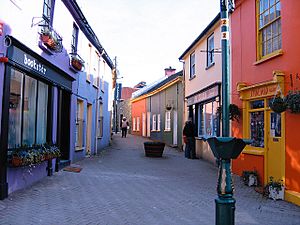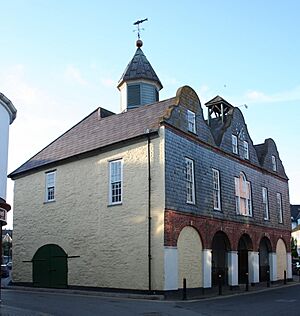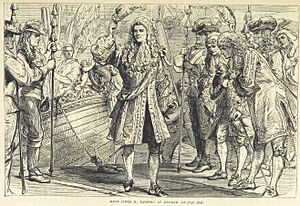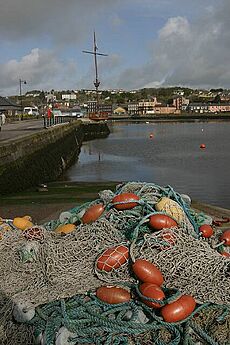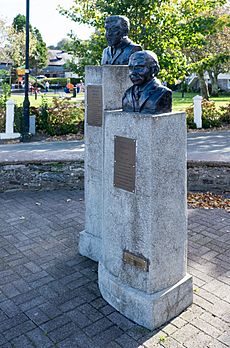Kinsale facts for kids
Quick facts for kids
Kinsale
Irish: Cionn tSáile
|
|
|---|---|
|
Town
|
|
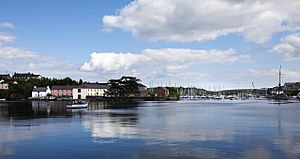
Inner Kinsale harbour and marina
|
|
| Country | Ireland |
| Province | Munster |
| County | County Cork |
| Elevation | 10 m (30 ft) |
| Population
(2022)
|
5,991 |
| Time zone | UTC±0 (WET) |
| • Summer (DST) | UTC+1 (IST) |
| Eircode routing key |
P17
|
| Telephone area code | +353(0)21 |
| Irish Grid Reference | W637506 |
Kinsale (/kɪnˈseɪl/ KIN-sayl; Irish: Cionn tSáile, meaning head of the brine) is a historic port and fishing town in County Cork, Ireland. It is about 25 kilometers (15 miles) south of Cork City. Kinsale is located on the southeast coast, near the Old Head of Kinsale. It sits right at the mouth of the River Bandon.
As of the 2022 census, Kinsale has a population of 5,991 people. This number grows a lot in the summer because many tourists visit. The town is part of a civil parish with the same name.
Kinsale is a very popular holiday spot for both Irish and international visitors. The town is famous for its many restaurants, including the Michelin-starred Bastion restaurant. It also hosts several annual food festivals that celebrate delicious local food.
Because it was once a very important port, Kinsale has many interesting old buildings. These include Desmond Castle, built around 1500, which was also known as the French Prison. There's also James's Fort, a 17th-century fort on the Castlepark peninsula. Another famous fort is Charles Fort, built in 1677, which is partly restored.
Other old buildings include the Church of St Multose from 1190 and St John the Baptist (a Catholic church) from 1839. The Market House, built around 1600, is also a notable historic building.
Contents
History of Kinsale
Kinsale has a long and interesting history. In 1334, King Edward III gave Kinsale a special document called a Royal Charter. This charter allowed the town to set up its own local government, called the Corporation of Kinsale.
This local government ran the town for over 500 years. Later, in 1840, a new law changed how towns were governed in Ireland. Local government in Kinsale was then managed by "town commissioners." These commissioners became the Kinsale Town Council in 1898. The Kinsale Town Council existed until 2014, when this type of local government was ended in Ireland.
Kinsale's Spanish Connections
Kinsale has also had important connections with Spain throughout its history. In 1518, Archduke Ferdinand, who later became Emperor Ferdinand I, made an unexpected visit to the town. One of his staff members wrote a detailed description of the people living there.
In 1601, a Spanish army arrived in Kinsale. This was the last time Spain sent a large fleet to attack the Kingdom of England. The Spanish wanted to join forces with Irish rebels to fight England through Ireland. This led to the famous Battle of Kinsale.
The Battle of Kinsale happened at the end of the Nine Years War. English forces, led by Charles Blount, 8th Baron Mountjoy, fought against the Irish rebel army. The Irish forces were led by Hugh O'Neill, 2nd Earl of Tyrone and Red Hugh O'Donnell. The Irish were also supported by King Felipe III of Spain. The English forces won this important battle.
A few years after the battle, in 1607, a major event called the Flight of the Earls took place. Many important Irish leaders, including Hugh O'Neill, left their lands and sailed to Continental Europe. Soon after the battle, James's Fort was built to protect Kinsale's harbor. It was finished by 1607 and designed to be a strong, star-shaped fort.
Forts and Royal Visits
In 1649, Prince Rupert of the Rhine announced that Charles II was the new King of England, Scotland, and Ireland. He did this at St Multose's Church in Kinsale. This happened after Charles I was executed in London during the English Civil War. Kinsale's harbor was a safe place for trading ships during these troubled times.
Charles Fort was built in 1677 during the reign of King Charles II. It is located at Summer Cove and guards the entrance to Kinsale Harbour. This fort was built to protect the area from French and Spanish ships. James's Fort, built earlier, is on the other side of the cove. In times of war, a strong chain could be stretched underwater between the two forts. This chain was meant to damage enemy ships trying to enter the harbor.
King James II landed in Kinsale in March 1689 with 2,500 soldiers. He had help from King Louis XIV of France. James II was trying to regain his power in England, Scotland, and Ireland. However, after his defeat at the Battle of the Boyne in 1690, James II returned to France from Kinsale.
From 1694, Kinsale became a supply base for the British Royal Navy in southern Ireland. Many storehouses were built there. However, only smaller ships could use the harbor because of a sandbar at the river's mouth. Kinsale's importance as a naval base decreased after 1805. The Royal Navy moved its main supply center to Cork harbour during the Napoleonic Wars.
On May 7, 1915, during the First World War, the ocean liner RMS Lusitania was sunk by a German submarine. Some of the bodies and survivors were brought to Kinsale. The official investigation into the deaths was held in the town's courthouse. There is a statue in the harbor that remembers this event.
Kinsale used to have a train line from 1863 to 1931. The train station was on Barrack Hill, and the line connected to the main railway system. However, the station was not very convenient for the town, and the line was closed.
In 2005, Kinsale became Ireland's second Fair Trade Town. This means the town supports fair prices and good working conditions for producers in developing countries. In 2020, Condé Nast Traveler magazine called Kinsale one of the "20 most beautiful villages in the UK and Ireland."
Getting Around Kinsale
Bus Éireann provides the main public transport in Kinsale. Buses run regularly from Kinsale to Cork City. Most of these buses also stop at Cork Airport on the way. There is also a bus service that connects Kinsale and Bandon.
The Archdeacon Duggan Bridge, located southwest of the town, opened in March 1977. It was named after Father Tom Duggan, a chaplain in both World War I and World War II. This bridge replaced an older iron bridge from the 1880s.
Learning in Kinsale
Kinsale has several schools for both younger children and teenagers. The town's community school has won "Best School in the Republic of Ireland" twice. It also received awards at the BT Young Scientist Exhibition in 2014.
Kinsale College offers many courses for further education after secondary school. The town also has a school where people can learn English.
Community and Sports in Kinsale
The Kinsale Yacht Club (KYC) started in 1950. It is a sailing club that organizes events for sailors of all ages. They have junior sailing programs with different types of boats. The club also has races for various yacht classes.
Kinsale Rugby Football Club was founded in 1982. Its grounds are used for the yearly Kinsale Sevens event. This event attracts rugby teams from all over the world and thousands of fans.
The Kinsale GAA club plays in the Carrigdhoun division of Cork GAA. They won the Cork Football Intermediate County Championship in 2011. This was their first win since 1915!
Kinsale Badminton club is located in St Multose Hall. It has activities for both adults and young players. The club also enters teams in Cork county Leagues and Cups.
The Kinsale Branch of the Irish Red Cross has been helping the community since 1939. It is run by volunteers who provide first aid at local events. The Kinsale Red Cross has two ambulances and trained volunteers.
Kinsale takes part in the Irish Tidy Towns Competition and won the overall award in 1986.
Kinsale is also Ireland's first 'Transition Town.' This means the community works together to become more sustainable and less reliant on fossil fuels.
Fun and Culture in Kinsale
Kinsale hosts an annual jazz festival every year. It takes place during the last weekend of October. Pubs and hotels in the town have live jazz and blues music all weekend.
The Great Wall of Kinsale is a large steel sculpture by Eilis O'Connell. It was put up in 1988 to celebrate Kinsale's success in the Tidy Towns competition. You can see it by Pier Road and Town Park.
Bastion, a restaurant on Market/Main streets, received a Michelin Star in 2020. The famous chef Keith Floyd used to live in Kinsale.
Sister Cities
Kinsale is connected with these towns around the world:
 Newport, Rhode Island, United States
Newport, Rhode Island, United States Mumbles, Wales
Mumbles, Wales Portofino, Italy
Portofino, Italy Antibes, France
Antibes, France
New Buildings in Kinsale
In recent years, new homes have been built in Kinsale. The Convent Garden project is near the old town center. It turned the former St Josephs Convent into 79 apartments. Also, 94 new houses were built in the grounds.
Another housing development, Abbey Fort, includes 260 homes at the north end of Kinsale. The first parts of this project were finished between 2007 and 2012.
People from Kinsale
Many interesting people have come from or lived in Kinsale:
- Aidan Higgins (1927–2015), a poet and novelist.
- Aisling Judge (born 1991), a scientist and winner of the Young Scientist and Technology Exhibition.
- Ciara Judge (born 1998), a scientist and winner of the Google Science Fair.
- Keith Floyd (1943–2009), a famous chef.
- Mortimer McCarthy (1882–1967), a sailor and explorer who went to Antarctica with Ernest Shackleton.
- Patrick Cotter O'Brien (1760–1806), known as the "Kinsale Giant," was one of the tallest men ever recorded.
- Timothy McCarthy (1888–1917), another sailor and explorer who went on Ernest Shackleton's expedition.
- William Penn (1644–1718), who founded the U.S. state of Pennsylvania, worked in Kinsale.
See also
 In Spanish: Kinsale para niños
In Spanish: Kinsale para niños




